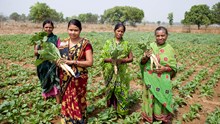
A seed may be small, but it carries the promise of a full harvest. However, this promise is often weakened by pests, humidity, mold, and unpredictable weather conditions between harvesting and sowing. These factors reduce the seed’s ability to germinate, ultimately impacting yield and productivity. The good news? Farmers now have access to simple, affordable, and effective solutions—seed coating and polymer technologies—that protect seeds, enhance germination, and boost overall crop yields.
Why Seed Quality Matters
Every farmer knows that sowing is more than just placing a seed into the soil—it's the beginning of the harvest cycle. Yet, many may overlook how critical seed quality is to final output. During storage and transport, seeds are vulnerable to damage from heat, moisture, insects, and fungi. These threats can significantly lower germination rates and reduce crop performance.
Studies show that high-quality seeds can improve yields by up to 20%. However, to maintain this quality, protective measures are necessary. This is where seed coating comes in—a technique that strengthens and safeguards seeds before they enter the soil.
Understanding Seed Coating: A Simple but Powerful Tool
Seed coating involves covering seeds with a protective layer that may include nutrients, pesticides, fungicides, or beneficial microbes. This coating enhances seed performance and supports early-stage plant growth.
Types of Seed Coating Techniques
-
Film Coating
A thin, transparent layer that protects without changing the shape or size of the seed.
-
Seed Encrusting
Adds volume and weight, making seeds more uniform and easier to sow, especially for tiny or irregular seeds.
-
Pelleting
Rounds off seeds and increases their size, which improves handling and precision sowing in machines.
-
Polymer Coating
The most farmer-friendly method, polymer coating involves using colored polymers mixed with chemicals to protect and enhance seed performance.
Polymer Coating at Home: Using Polykote
One of the most accessible forms of seed protection is polymer coating using a product called Polykote. Polykote is available in various colors and is mixed with water and other additives like:
-
Fungicides (e.g., Carbendazim)
-
Pesticides (e.g., Imidachloprid)

Step-by-Step Guide to Polymer Coating Seeds
-
Mix 3 grams of Polykote with 5 ml of water per kilogram of seeds.
-
Add desired protective chemicals (fungicides/insecticides) in safe quantities.
-
Pour the mixture over the seeds and shake well until evenly coated.
-
Spread the coated seeds in shade to dry.
-
Store the seeds in cool, dry conditions until sowing.
Matching the Right Polymer to the Right Crop
Different crops benefit from specific types and doses of Polykote. Here are some examples:
|
Crop |
Polykote Color |
Quantity (per kg seed) |
Water |
|
Paddy |
Yellow |
3 grams |
3 ml |
|
Maize, Millet, Sorghum |
Pink |
3 grams |
3 ml |
|
Soybean |
Yellow |
6 grams |
20 ml |
|
Sunflower |
Black |
6 grams |
20 ml |
|
Tomato |
Red |
6 grams |
20 ml |
|
Okra |
Varies |
Moderate |
Adjust as needed |
By using the correct type and amount of Polykote, farmers can tailor seed treatments to suit the specific needs of each crop.
Real-World Benefits of Seed and Polymer Coating
Farmers report noticeable improvements within days of using coated seeds:
-
Faster and more uniform germination
-
Healthier, stronger seedlings
-
Reduced seedling death from pests or diseases
-
Lower input costs as chemical treatments are more efficient
-
Safer seed handling and storage, with less chemical exposure
Most farmers observe a 5–10% increase in germination rates, meaning fewer seeds go to waste and more plants grow successfully—leading to higher yields without higher costs.
A Smarter Path to Food Security
Seed coating, especially through polymer technology, is not just for large-scale commercial farms or laboratories. It's a practical, cost-effective technique that even small-scale farmers can apply in their homes or villages.
In an era where farming faces challenges from climate change, rising costs, and soil degradation, seed coating stands out as a sustainable and empowering solution. By protecting the seed from the very beginning, farmers take a proactive step toward improving harvests, securing income, and supporting long-term food security for their communities.
















